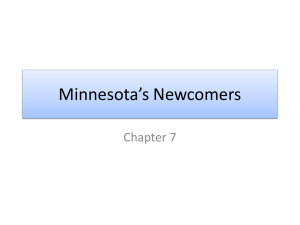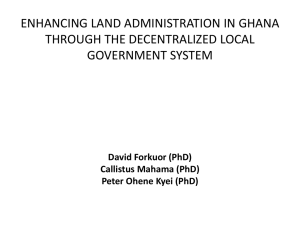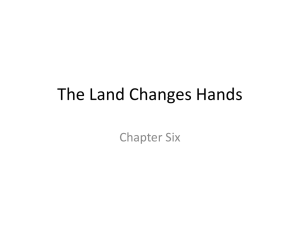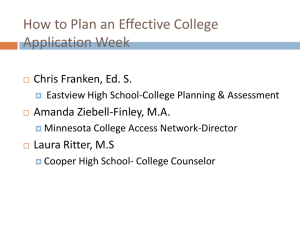An Historical Approach to Public Policy
advertisement
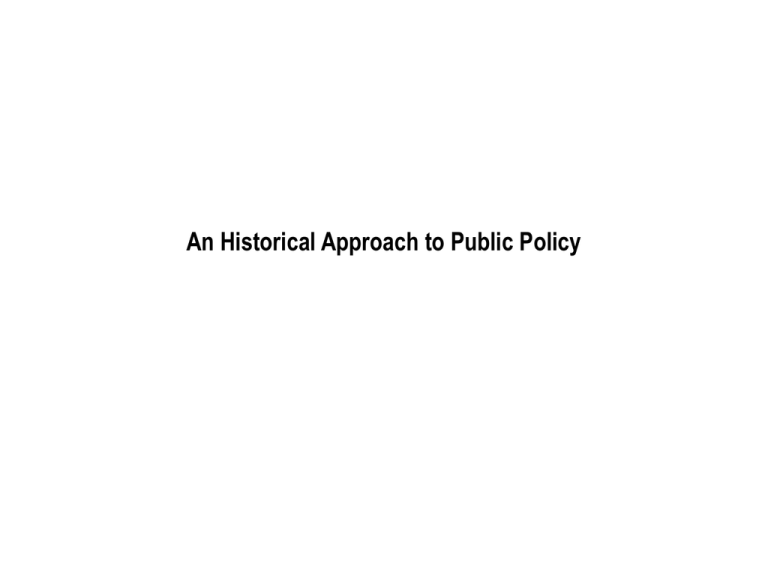
An Historical Approach to Public Policy A Paradigm for Landscape Legislation Regulation Judicial Opinions Activities Goods Services Structures Organization of Space Landscape Law Public Policy Organization of Behavior Government Role Evaluation Indices Evaluation A Paradigm for Landscape Legislation Regulation Judicial Opinions Activities Goods Services Structures Organization of Space Landscape Law Public Policy Organization of Behavior Government Role Indices Evaluation I describe landscapes through a lens of public policy – government decisions Here, • How the U.S. government organized space for ownership purposes • How the U.S. government promoted privatization of land through regulation, coercion, constructing public works, collecting and disseminating information A Paradigm for Landscape Legislation Regulation Judicial Opinions Activities Goods Services Structures Organization of Space (Public Land Surveys) Settlement Effective state government Law Public Policy Organization of Behavior (Settlers, Landowners) Government Role Acres conveyed $ received Evaluation A History Lesson We are connected to the past in many ways some are subtle, most are obvious, although not recognized We don’t look at them in the “right way” Twin Foci How the United States conveyed title to the land it acquired from foreign governments and American Indians How the United States divided the and surface, created place from space, as a necessary prerequisite for conveying title Beginnings to Present 2012 Beginnings to Present 1849 2012 United States Policy In the eighteenth & nineteenth centuries individuals migrated into a largely uninhabited continental interior Promoted by a policy that rested on two features • Creating private landowners – individuals with legal rights • Creating governments protecting the legal rights of those landowners Resources Linklater, Andro. The Fabric of America: How Our Borders and Boundaries Shaped the Country and Forged Our National Identity (New York. Walker & Co. 2008) Rohrbough, Malcolm The trans-Appalachian frontier : people, societies, and institutions, 1775-1850 (New York. Oxford University Press,1978) Resources A Century of Lawmaking for a New Nation (Library of Congress) HeinOnline • U.S. Statutes at Large • U.S. Congressional Documents - Debates in Congress • American State Papers • Territorial Papers of the United States • Treaty Publications – Indian Affairs, Laws and Treaties U.S. Congressional Serial Set (Readex) ProQuest Congressional coverage Main Processes Congress signed treaties with Native American groups in which the aboriginal title of the groups was extinguished giving the United States "fee title" to land Main Processes Congress signed treaties with Native American groups in which the aboriginal title of the groups was extinguished giving the United States "fee title" to land The ceded lands were surveyed, divided up into conveniently sized parcels, and title to them conveyed to individuals, corporations, and even states Main Processes Congress signed treaties with Native American groups in which the aboriginal title of the groups was extinguished giving the United States "fee title" to land The ceded lands were surveyed, divided up into conveniently sized parcels, and title to them conveyed to individuals, corporations, and even states Congress created governments to define and guarantee the rights of those who acquired land Northwest Ordinance Jurisdiction over individuals and title to lands in the Northwest Territory would be vested in a national government Provided individuals who settled in the Territory with a government, hence some guarantee of their rights Established how the Northwest Territory would be divided - into sovereign states The “model” of early governments in 31 states United States Acquiring Jurisdiction United States Acquiring Title Congress signed treaties with Native American groups in which the aboriginal title of the groups was extinguished giving the United States "fee title" to land Indian Areas Judicially established 1978 Indian Land Cessions in the United States, 1794-1894 Native American Cessions in Minnesota Treaties Representatives of the United States and various American Indian bands negotiated 370 treaties of peace throughout the country from 1787 to 1871 - most involved land cessions After 1850s they also involved reservations They were not neat expressions of public intent and their language has become very contentious • Reflected ambiguous and contradictory principles and practices that characterized the relationship between American Indians and non-Indians • Reflected the ambiguous and contradictory principles and practices that characterized federal land policy designed to promote and subsidize the colonization of the United States by landowners Main Processes The ceded lands were surveyed, divided up into conveniently sized parcels, and title to them conveyed to individuals, corporations, and even states The Land Ordinance, 1785 Established two general principles • Lands north and west of the River Ohio ceded by Native Americans would be subdivided in an orderly manner • The United States would convey title to these lands to individuals, corporations and states United States Creating Place out of Space Resources Donaldson, Thomas C. The Public Domain. Its history, with statistics (Wasington DC. Government Printing Office, 1881) also published as House Executive Document 47 Part 4 46th Congress 3d session, Serial 1975 Annual Report of the Commissioner of the General Land Office – Congressional Documents - U.S. Congressional Serial Set (Readex) Spatial Organization Real property Townships Sections Transformed "formless wilderness into a remarkable national geometry of squares and rectangles" The Public Land Surveys The purpose of subdividing the land surface was to provide a "legal description" of the land the federal government would privatize • to establish boundaries of a parcel of land that would be conveyed • to establish the location of a parcel of land that would be conveyed As the land surface was subdivided, and boundaries and location established, an inventory was made of the surface, describing the features that were thought to be relevant to prospective landowners, and maps were made The surveys were carried out by a cadre of deputy surveyors under contract with the federal government Rectangular Public Land Survey Basics The Township Plat - the first large scale maps • the location of the boundaries to parcels of land in the township • the general nature of the land surface in the township • the specific topographic features in the township The Township Plat - the first large scale maps • the location of the township in the United States • the location of the boundaries to parcels of land in the township • the general nature of the land surface in the township • the specific topographic features in the township Locational Control Resources White, C. Albert. (1982) A History of the Rectangular Survey System (Washington, Government Printing Office) Dodds, J. S. (ed.) Original instructions governing public land surveys 1815-1855; a guide to their use in resurveys of public lands (Ames, IA. Iowa State University, 1943) General Land Office. Instructions to the surveyors general of public lands of the United States : for those surveying districts established in and since the year 1850 (Washington DC. A O P Nicholson, Public Printer,1855) Minnesota Kinney, Gregory and Lydia Lucas. Guide to the Records of Minnesota’s Public Lands (Minnesota Historical Society, Division of Archives and Manuscripts, 1985) GLO Historic Plat Map retrieval system Squires, Rod. "An Inventory of the Public Land Surveys Records for Minnesota: The Special Instructions" (Minneapolis, Minn. Center for Transportation Studies, 2008) Squires, Roderick H. Vignettes of the public lands surveys : a striking triumph of geometry over physical geography (St. Paul. Minnesota Society of Professional Surveyors, 2010) Squires, Rod. The public land survey records in Minnesota : an inventory and description of the deputy surveyor contracts in the Minnesota Historical Society collections: final report (Minneapolis, Minn. Center for Transportation Studies, 2012) Squires, Rod. Reconciling the Public Land Surveying Process and the Available Records (Minneapolis, Minn. Center for Transportation Studies, 2013) Spatial Organization Spatial Organization T.28N R.22W Spatial Organization T.28N R.22W Unpacking Spatial Organization N.½ Section 31 Spatial Organization N.½ Section 31 Part of SE¼ NW¼ Section 31 T28N 22W Plat Lot 2 Block 1 Grieve Glen The Rectangular Grid in Minneapolis and St. Paul 1848 1866 United States Conveying Title to Land Resources Gates, Paul Wallace. History of Public Land Law Development (Washington DC. Government Printing Office, 1968) Donaldson, Thomas C. The Public Domain. Its history, with statistics (Wasington DC. Government Printing Office, 1881) also published as House Executive Document 47 Part 4 46th Congress 3d session, Serial 1975 Rohrbough, Malcolm J. The Land Office Business : the settlement and administration of American public lands, 1789-1837 (Belmont, Calif. Wadsworth Pub. Co. 1990) Dana, S. T., J. H. Allison, and R. N. Cunningham. Minnesota lands: ownership, use, and management of forest and related lands (Washington, American Forestry Association 1960) Land Conveyances by the United States Disposition of the Federal Lands A Few of the 3,500 Statutes Lands Conveyed by the United States under several statutes Timber Culture Act, 1873 Alienation of Minnesota’s Land Surface Land District Offices Land Subsidies to Railroads Lake Superior & Mississippi RR Grant The first landowner in Minnesota Minnesota Trust Fund Land

